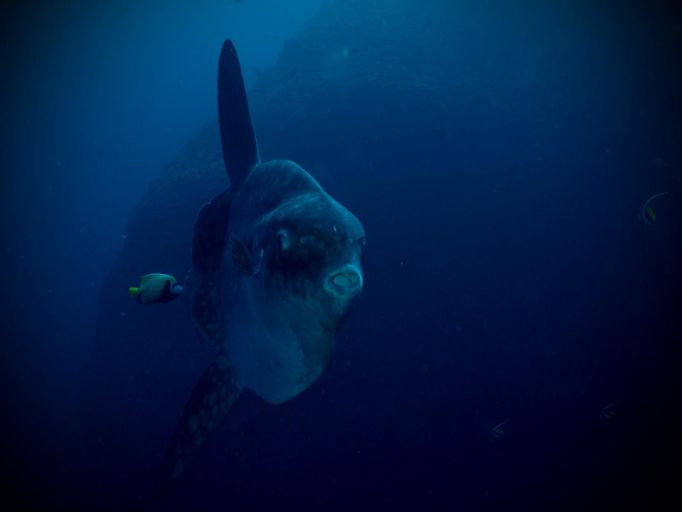Nusa Penida and Nusa Lembongan, two premier diving destinations in Bali, offer an array of spectacular dive sites that attract divers worldwide. The most popular site in Nusa Penida is Crystal Bay, known for its crystal-clear waters and cleaning stations for the impressive Mola Mola, or Oceanic Sunfish, which can be seen from June to October. The northern drift dives at PED, SD, and Sental feature vibrant coral reefs and diverse marine life, while Manta Point on the southern side is famous for its year-round population of majestic Manta Rays. In Nusa Lembongan, the Mangrove and Blue Corner are notable for their pristine reefs and abundant marine life, including sharks, rays, and the elusive Mola Mola.
Diving conditions in Nusa Penida and Nusa Lembongan are ideal, with visibility often ranging from 20 to 30 meters and water temperatures around 27ºC, although they can drop to 16ºC between July and September. Most dive sites in this region are drift dives, benefiting from mild to strong currents, and are conveniently located just 5 to 20 minutes from dive centers, making daily diving trips easy and enjoyable. These islands offer unparalleled diving experiences for both experienced divers and beginners, from encounters with Mola Mola and Manta Rays to exploring vibrant coral reefs and thrilling drift dives.
Crystal Bay
Located in Nusa Penida, southeast of Bali, Crystal Bay is just a 40-50 minute boat ride from Sanur or Padang Bai. This dive site offers depths ranging from 5m to 40m, with excellent visibility (15m-30m) and water temperatures between 16°C to 26°C, especially colder from July to October. Strong and unpredictable currents make it more suitable for intermediate to advanced divers.
Crystal Bay is famous for seasonal Mola Mola (ocean sunfish) sightings from July to October, along with reef sharks, turtles, and Napoleon wrasse. The site boasts stunning coral reefs, macro life like frogfish and nudibranchs, and schooling fish such as Trevallies, Batfish, and Sweetlips.
For the best experience, diving with a local guide is recommended, and a 5mm wetsuit helps with the cold thermoclines. Whether you’re looking for big pelagic encounters or rich coral landscapes, Crystal Bay is a must-visit dive site in Nusa Penida.


Toyapakeh
Toyapakeh, located on the northwest coast of Nusa Penida, is one of the island’s richest dive sites, known for its stunning coral reefs and diverse marine life. Just a 40-50 minute boat ride from Bali’s mainland, this site offers depths from 5m to 40m, with excellent visibility (15m-30m) and water temperatures ranging from 20°C to 28°C. While currents can be strong, the area also has sheltered spots suitable for all diver levels.
Divers can encounter schooling Trevallies, Batfish, and Sweetlips, along with reef sharks, turtles, and the occasional Mola Mola during the colder months (July-October). The site is also home to vibrant soft and hard corals, frogfish, nudibranchs, and other macro species.
For the best experience, diving with a local guide is recommended, as currents can be unpredictable. With its breathtaking underwater scenery and marine biodiversity, Toyapakeh is a must-visit dive site in Nusa Penida.
Manta Point
Manta Point, located on the southwest coast of Nusa Penida, is the best place to encounter majestic manta rays year-round. A 45-60 minute boat ride from Bali, this dive site offers depths of 5m to 25m, with visibility ranging from 10m to 20m. Water temperatures are cooler (20°C to 26°C), and while currents are generally mild, surge conditions can be present due to open ocean exposure.
The highlight of Manta Point is the resident reef mantas (Manta alfredi), often seen gliding gracefully over cleaning stations. Divers may also spot bamboo sharks, stingrays, and various macro species among the rocky seabed and coral formations.
Suitable for all levels, this site provides an unforgettable experience, especially when diving with an experienced guide. With its spectacular manta ray encounters, Manta Point is a must-visit for any diver in Nusa Penida.


Manta Bay
Manta Bay, located on the southwest coast of Nusa Penida, is a shallow dive site famous for year-round manta ray sightings. Just a 30-45 minute boat ride from Bali, it offers depths of 5m to 15m with visibility ranging from 10m to 20m. Water temperatures range from 20°C to 26°C, and surface conditions can be choppy due to open ocean exposure.
Unlike Manta Point, Manta Bay is shallower, making it ideal for snorkelers and beginner divers. Reef mantas (Manta alfredi) are commonly seen feeding near the surface, while the rocky reef below is home to stingrays, reef fish, and occasional turtles.
With its breathtaking scenery and frequent manta encounters, Manta Bay is a top choice for divers and snorkelers seeking a close-up experience with these graceful giants.
Lembongan Bay
Lembongan Bay, located on the northwest coast of Nusa Lembongan, is a calm and shallow dive site perfect for beginners and macro lovers. Just a 30-40 minute boat ride from Bali, it features depths ranging from 3m to 12m, with good visibility (10m-20m) and warm water temperatures (26°C to 30°C). The gentle conditions make it an excellent spot for training dives and snorkeling.
The sandy bottom and coral bommies host a variety of marine life, including frogfish, nudibranchs, scorpionfish, and cuttlefish. Schools of damselfish, clownfish, and angelfish add vibrant colors to the reef, while occasional bamboo sharks and stingrays can also be spotted.
With easy conditions and rich biodiversity, Lembongan Bay is a great choice for relaxed diving and underwater photography in Nusa Lembongan.


North Penida
The north coast of Nusa Penida offers some of the best drift diving in Bali, with long, healthy coral reefs teeming with marine life. Sites like SD Point, Ped, Sental, and Buyuk feature depths from 5m to 40m, excellent visibility (15m-30m), and water temperatures between 20°C and 28°C. Strong currents make these sites ideal for intermediate to advanced divers.
Divers can glide over colorful coral gardens filled with reef sharks, turtles, and schooling fish like Trevallies, Batfish, and Fusiliers. Macro lovers will find nudibranchs, leaf scorpionfish, and frogfish among the reef. From July to October, lucky divers may also spot the elusive Mola Mola.
With breathtaking underwater scenery and thrilling drift conditions, North Penida is a must-visit for those seeking an exciting dive experience.
Gamat Bay
Gamat Bay, located on the northwest coast of Nusa Penida, is a small yet stunning dive site known for its rich coral formations and diverse marine life. With depths ranging from 5m to 30m, visibility of 15m to 25m, and water temperatures between 20°C and 28°C, this site offers both gentle shallows and exciting deeper areas. Strong currents make it ideal for intermediate to advanced divers.
The site features vibrant coral bommies, overhangs, and sandy patches where macro lovers can spot nudibranchs, frogfish, and scorpionfish. Larger marine life includes reef sharks, turtles, and schooling Trevallies. Drift divers will enjoy the exhilarating underwater landscape as they glide along the reef.
With its mix of macro life, coral diversity, and thrilling currents, Gamat Bay is a must-visit dive site for adventurous divers in Nusa Penida.


Blue Corner
Blue Corner, located off the northwest coast of Nusa Lembongan, is a deep and challenging dive site famous for its strong currents and pelagic encounters. With depths ranging from 20m to 40m, visibility of 15m to 30m, and water temperatures between 18°C and 26°C, this site is recommended for advanced divers with drift diving experience.
The sloping reef and deep ledges attract large marine life, including reef sharks, rays, and schools of Trevallies and Barracudas. Between July and October, Blue Corner is one of the best spots to encounter the elusive Mola Mola (ocean sunfish). Due to unpredictable currents and downflows, diving with an experienced local guide is essential.
For those seeking an adrenaline-filled dive with the chance to see big pelagics, Blue Corner is one of Nusa Lembongan’s most exciting sites.
Mangrove
Mangrove, located on the north side of Nusa Lembongan, offers a beautiful drift dive along healthy coral reefs. With depths ranging from 5m to 25m, visibility of 15m to 30m, and water temperatures between 24°C and 28°C, it is suitable for divers of all levels. The moderate current provides a smooth and enjoyable drift experience.
The site features stunning hard and soft coral gardens teeming with marine life, including reef fish, moray eels, and turtles. Schools of Trevallies, Fusiliers, and Batfish are commonly seen, while macro lovers can spot nudibranchs and scorpionfish hiding among the corals.
With its gentle currents and colorful underwater scenery, Mangrove is perfect for a relaxed yet exciting dive in Nusa Lembongan.

